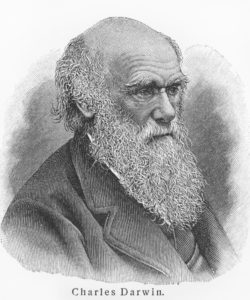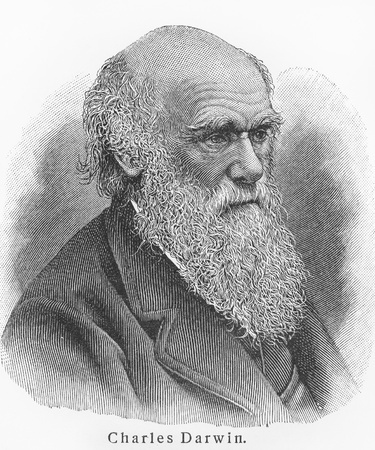
Surrounded by family members and in the arms of his loving wife Emma, Charles Darwin died on Wednesday, April 19, 1882. Among his last spoken words was a statement that he was not “the least afraid to die.” Darwin’s hope, and the family’s original intention, was for him to be buried in the family vault in St. Mary’s church at Downe. History intervened, and Charles Darwin was instead interred in Westminster Abbey on the morning of April 26, 1882—not far from the resting place of Sir Isaac Newton. Ironically, although Darwin indentified himself as an agnostic, and said he had rejected Christianity at the age of forty, within two weeks of his burial, there was a sermon preached in Wales saying that Darwin had, “in his last utterances confessed his true faith.” The problem is, it wasn’t true.
Dearman Birchall, his wife and their four children had taken a holiday at the southern Wales resort town of Tenby. On May 7th they heard a minister named Huntingdon preach a sermon in which: “He spoke of Darwin one of the greatest thinkers who had in his last utterances confessed his true faith.” The quote was from a diary entry, and can be found in The Darwin Legend, by James Moore. There were other scattered rumors of a deathbed conversion by Darwin over the next three decades, including an 1887 sermon in Toronto by the Reverend John Mutch. This led a reporter for the Toronto Mail to write to Darwin’s close friend and supporter, Thomas Huxley to confirm the truth of Mutch’s statement. Huxley’s reply, on February 12, 1887 follows:
I have the best authority for informing you that the statement which you attribute to the Revd Mr. Mutch of Toronto that “Mr Darwin, when on his death bed, abjectly whined for a minister and renouncing Evolution, sought safety in the blood of the Saviour” is totally false and without any kind of foundation.
Huxley consulted Darwin’s son Francis, who gave Huxley permission to reply to the reporter, denying any deathbed conversion of his father. Yet the question is how such a rumor could have arisen and been repeated by a minister so far away from Darwin’s home in Downe. James Moore convincingly demonstrated the likely source was a British evangelist active in the temperance movement, named Elizabeth Cotton, who became Lady Hope in 1887 when she married Sir James Hope. She reported meeting Darwin in the autumn of 1881, about six months before his death.
However the story of their meeting did not appear in print for thirty-four years. Moore speculated that if this encounter was the origin of all the post-1882 deathbed stories of Darwin’s conversion, it was spread initially by word of mouth among English evangelicals and their American connections. John Mutch could then have heard the story from someone in those circles and repeated it in his 1887 sermon. “Whatever the case, there is no doubt that Lady Hope was making discreet comments about Darwin to her religious friends long before the story was published.”
In August of 1915 Lady Hope was in East Northfield Massachusetts for the annual conference at Northfield Seminary, the girl’s preparatory school founded by D. L. Moody. She approached one of the speakers, A. T. Robertson, and told him her story of Darwin’s conversion. Robertson then repeated it when he next spoke. An editor from the Watchman-Examiner was there and insisted Lady Hope write the story out so he could publish it, giving it “the widest publicity.” Two weeks later, the Watchman-Examiner carried her story under the title, “Darwin and Christianity.”
In The Darwin Legend, Moore quoted the entire story, which can also be found in the Wikipedia entry for “Elizabeth Cotton, Lady Hope.” The story went “viral,” to use a modern idiom, with over fifty known texts identified by James Moore that repeated the Lady Hope legend through 1993, when he published his book. The story happened to take place in the midst of the anti-evolution crusade involving William Jennings Bryan and the “monkey trial” of 1925. See “Structure of an Evolutionary Revolution” for more on Bryan and the Scopes Trial. Bryan did not repeat the story even though he knew of it, saying that using it would only aid the other side in the fight against evolution. But that did not deter others.
Members of Darwin’s family repeatedly and vehemently denied Lady Hope’s story. Darwin’s son Francis, who edited The Life and Letters of Charles Darwin, including an Autobiographical Chapter, in 1887, wrote Huxley in 1887 about the Toronto Mail reporter. He said: “By all means answer as you propose. You have my authority that the statement is false and without any kind of merit.” Francis wrote at least three letters after the Lady Hope story was published denying its veracity. In a letter to the secretary of the Protestant Press Bureau, on May 28, 1918, Francis said:
Lady Hope’s account of my father’s views on religion is quite untrue. I have publically accused her of falsehood, but I have not see a reply. My father’s agnostic point of view is given in my “Life and Letters of Charles Darwin,” Vol. I., pp. 304-317. You are at liberty to publish the above statement. Indeed, I shall be glad if you will do so.
Henrietta Darwin Litchfield, Darwin’s third daughter and the eldest daughter to reach adulthood, responded to an enquiry from the editors of The Christian, an interdenominational evangelical weekly, who asked her to confirm or deny the truth of a “highly-colored story . . . going the round of the American papers” about her father’s death-bed. If it was true, then many people would have been glad to learn that “some higher and deeper devotion claimed his soul.” If it wasn’t true, then “the facts should be known.” On February 23, 1922 in The Christian, Henrietta said:
I was present at his deathbed. Lady Hope was not present during his last illness, or any other illness. I believe he never even saw her, but in any case, she had no influence over him in any department of thought or belief. He never recanted any of his scientific views, either then or earlier. We think the story of his conversion was fabricated in [the] U.S.A. In most of the versions hymn-singing comes in, and a summer-house where the servants and villagers sang to him. There is no such summer-house, and no servants or villagers ever sang hymns to him. The whole story has no foundation whatsoever.
Lady Hope died in Sydney Australia on March 9, 1922. She had traveled there for medical treatment for breast cancer. Eighteen years after her death, a professor of biology, S. James Bole, published an undated letter he had received from her in the early 1920s, having promised to keep it private during her lifetime. He had written to her, “asking for the story.” Lady Hope said Darwin heard she was in his village, holding meetings to discuss the Gospel and Temperance and asked if she would call upon him. She said when she arrived, he had a large Bible open before him to the book of Hebrews, which he said was “the Royal Epistle.” The contents of the letter to Bole are quite similar to the account Lady Hope gave in the Watchman-Examiner.
Darwin is supposed to have commented on some of the great Gospel truths to her, and how Christ was the King, Savior and Intercessor. When Lady Hope asked him about certain doubts that were raised about Creation from what he wrote,
He seemed greatly distressed, his fingers twitched nervously, and a look of agony came over his face as he said: “I was a young man with unformed ideas. I threw out queries, suggestions, wondering all the time over everything, and to my astonishment, the ideas took like wildfire. People made a religion of them.”
So she continued to tell her story until the day she died. But as Francis Darwin said, if his father had had an evangelical conversion experience in the last years of his life, surely that would have become known to his family. They have spoken and were quoted above as saying it never happened.
However, there is an outside chance that some kind of an encounter happened between Darwin and Lady Hope, but it would not have unfolded as she related in her story. Lady Hope was in Downe Village, near the Darwin estate, in September and possibly early October of 1881. Moore said: “The story, though imaginative, cannot be dismissed as pure invention. It contains striking elements of authenticity, to which Lady Hope added convincing new detail.”
For proprieties sake, she would not have met with him alone; and a likely third party would have been Darwin’s wife, Emma, who was well known for her own Unitarian faith. Before they married, his father, Robert Darwin, warned Charles that a husband should conceal his religious doubts from his wife so that she didn’t fear for his salvation. The younger Darwin ignored his father’s advice, revealing his doubts to Emma while they courted. When she was first pregnant, she wrote him that she didn’t feel she could say exactly what she wanted to him. What if she died in childbirth? Would he join her in heaven? It would be a nightmare “if I thought we did not belong to each other forever.”
Emma’s silence on the possibility of a conversion experience by her husband in the final months of his life speaks loudly to the fact that it did not happen. After her husband’s death, the family debated over whether a section of his autobiography, a private narrative originally written only for family members, should be published. In a section on religious beliefs Darwin had wondered how anyone “ought to wish Christianity to be true,” given its doctrine of everlasting punishment for unbelievers. For in those numbers would be his father, his older brother Erasmus, and almost all his best friends. Emma wrote to Francis, who was editing the Life and Letters, wondering how Charles’s religious friends would react to the sometimes-raw honesty of his thoughts. If there had been any legitimate reversal in Darwin’s agnosticism at the end of his life I think Emma would have insisted on its inclusion.
The autobiography was dismembered, the section on religious belief was removed to a separate chapter in the Life and Letters, and only “extracts, somewhat abbreviated,” were printed.
The unedited version of Life and Letters with Darwin’s clear rejection of many basic Christian beliefs would not be published until 1958, almost 100 years after Origin of the Species. Darwin’s unvarnished religious convictions were apparently more of a concern than his scientific ones.





